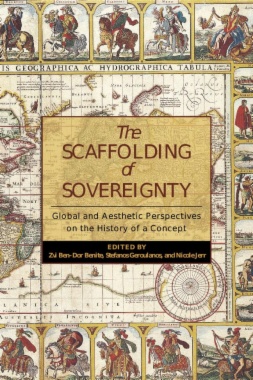What is sovereignty? Often taken for granted or seen as the ideology of European states vying for supremacy and conquest, the concept of sovereignty remains underexamined both in the history of its practices and in its aesthetic and intellectual underpinnings. Using global intellectual history as a bridge between approaches, periods, and areas, The Scaffolding of Sovereignty deploys a comparative and theoretically rich conception of sovereignty to reconsider the different schemes on which it has been based or renewed, the public stages on which it is erected or destroyed, and the images and ideas on which it rests.
The essays in The Scaffolding of Sovereignty reveal that sovereignty has always been supported, complemented, and enforced by a complex aesthetic and intellectual scaffolding. This collection takes a multidisciplinary approach to investigating the concept on a global scale, ranging from an account of a Manchu emperor building a mosque to a discussion of the continuing power of Lenin’s corpse, from an analysis of the death of kings in classical Greek tragedy to an exploration of the imagery of “the people” in the Age of Revolutions. Across seventeen chapters that closely study specific historical regimes and conflicts, the book’s contributors examine intersections of authority, power, theatricality, science and medicine, jurisdiction, rulership, human rights, scholarship, religious and popular ideas, and international legal thought that support or undermine different instances of sovereign power and its representations.
- Table of Contents
- Foreword, by Dick Howard
- Editors' Introduction, by Zvi Ben-Dor Benite, Stefanos Geroulanos, and Nicole Jerr
- Part I. Stages
- 1. Sad Stories of the Death of Kings: Sovereignty and Its Constraints in Greek Tragedy and Elsewhere, by Glenn W. Most
- 2. Contested Sovereignty: Heaven, the Monarch, the People, and the Intellectuals in Traditional China, by Yuri Pines
- 3. Nurhaci's Gambit: Sovereignty as Concept and Praxis in the Rise of the Manchus, by Nicola Di Cosmo
- 4. The Living Image of the People, by Jason Frank
- Part II. Courts
- 5. Public Health, the State, and Religious Scholarship: Sovereignty in Idrīs al-Bidlīsī's Arguments for Fleeing the Plague, by Justin Stearns
- 6. The Dancing Despot: Toyotomi Hideyoshi and the Performative Symbolism of Power, by Stanca Scholz-Cionca
- 7. Liberal Constitutionalism and the Sovereign Pardon, by Bernadette Meyler
- 8. The Vanishing Slaves of Paris: The Lettre de Cachet and the Emergence of an Imperial Legal Order in Eighteenth-Century France, by Miranda Spieler
- 9. Re-touching the Sovereign: Biochemistry of Perpetual Leninism, by Alexei Yurchak
- Part III. Acts
- 10. Hijra and Exile: Islam and Dual Sovereignty in Qing China, by Zvi Ben-Dor Benite
- 11. The Neurology of Regicide: Decapitation Experiments and the Science of Sovereignty, by Cathy Gere
- 12. The "Millennium" of 1857: The Last Performance of the Great Mughal, by A. Azfar Moin
- 13. Exit the King? Modern Theater and the Revolution, by Nicole Jerr
- Part IV. Shifts
- 14. Revolution in Permanence and the Fall of Popular Sovereignty, by Dan Edelstein
- 15. Exile Within Sovereignty: Critique of "The Negation of Exile" in Israeli Culture, by Amnon Raz-Krakotzkin
- 16. Affective Sovereignty, International Law, and China's Legal Status in the Nineteenth Century, by Li Chen
- 17. The Sovereignty of the New Man After Wagner: Artist and Hero, Symbolic History, and the Staging of Origins, by Stefanos Geroulanos
- List of Contributors
- Index

